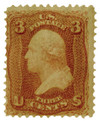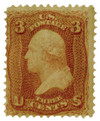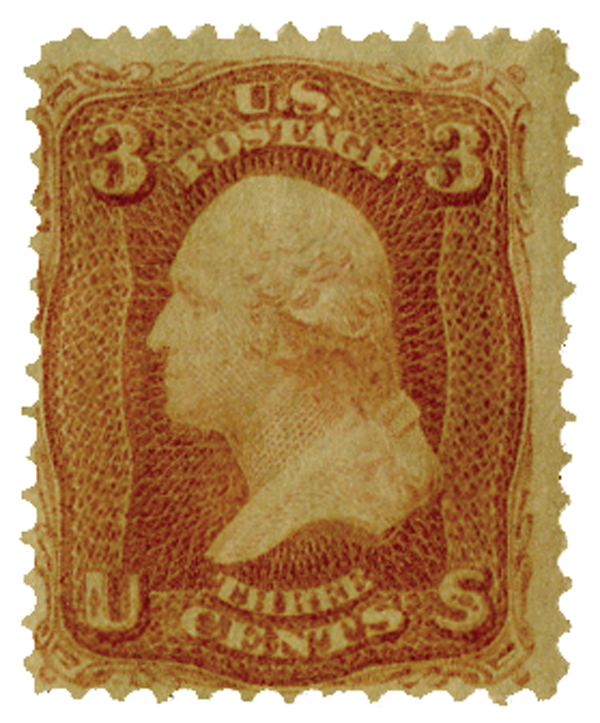
# 79 - 1867 3c Washington, rose "A" grill
U.S. #79
Series of 1867 3¢ Washington
“A” Grill
Earliest Known Use: August 13, 1867
Method: Flat plate
Watermark: None
Perforation: 12
Color: Rose
The A grill was National Bank Note Company first experiment with grilling. It covered the entire stamp area. Since it greatly weakened the paper and perforations, the A grill was discontinued after use on the 3-, 5-, and 30-cent issues.
Grills were made by embossing the stamp, breaking paper fibers, and allowing canceling ink to soak deeply into the paper. This made it difficult to remove cancels and reuse stamps. Charles Steel, who oversaw postage stamp production in the 1860s, patented the grilling method. It was used nine short years – 1867 to 1875. Grilling resulted in some of the greatest US stamp rarities, including the legendary “Z” Grill, US #85A.
Series of 1867
Grills are classified by the dimensions of the grill pattern and are measured in millimeters or by counting the number of grill points. There are eleven major classifications.
“A” Grill Covers the entire stamp
“B” Grill 18x15mm (22x18pts)
“C” Grill 13x16mm (16-17x18-21pts)
“D” Grill 12x14mm (15-17-18pts)
“Z” Grill 11x14mm (13-14x18pts)
“E” Grill 11x13mm (14x15-17pts)
“F” Grill 9x13mm (11-12x15-17pts)
“G” Grill 9-½ x9mm (12x11-11 ½ pts)
“H” Grill 10x12mm (11-13x14-16pts)
“I” Grill 8-½ x10mm (10x11x10-13pts)
“J” Grill 7x9 ½ mm (10x12pts)
The letters that classify the various grill types do not denote the size, shape, or appearance of the grills. Rather, they simply indicate the order in which they were discovered.
The exception to the rule is the “Z” grill, which was identified by William L. Stevenson. Stevenson could not decide to which family of grills this particular type belonged. Nor did he know which other families it preceded or followed and so he designated it as “Z Grill,” where “Z” signifies the unknown.
Visible in general from the back of the stamp only, grills may also be felt by lightly running a fingertip over the surface. Depending on which type of roller was used, the pattern may be “points up” or a “points down.” The ridges on an indented roller force the paper into the recesses, creating raised points, while a roller with raised pyramids will cause the points to be forced down into the paper, forming a series of depressions.
The United States was the first country to issue grilled stamps and was the only country to do so until the mid-1870s, when Peru also began using grills. The National Bank Note Company was responsible for producing both countries’ stamps.
First U.S. Grilled Stamp
Many early U.S. stamps didn’t have set issue dates, so for those, we go by the first known use, which for #79 was 150 years ago today!
In the 1860s, U.S. postal officials grew concerned that people were reusing stamps by washing the cancels off to use the same stamp twice. So Charles Steel, superintendent of stamp manufacture at the National Bank Note Company developed the grill process, for which he was granted a patent on October 22, 1867.
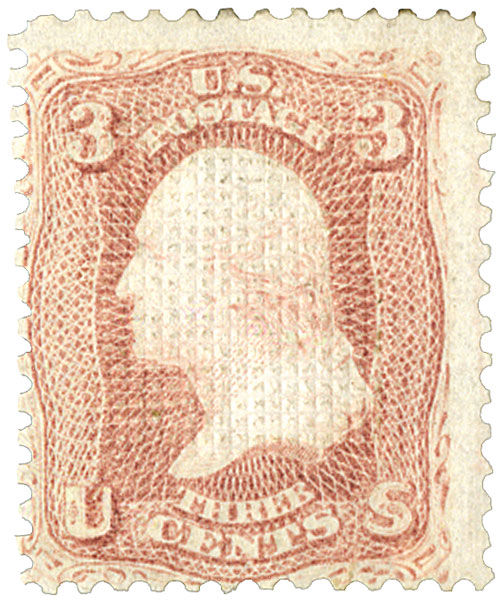
According to Steel’s patent, “The object of my invention is to produce a stamp which shall stick better than usual, and which it shall be impossible to fraudulently remove and use again.” Steel’s machine used a roller pitted with either small depressions or small raised pyramids to break fibers in stamp paper. The rollers with depressions created a “points up” pattern while those with raised pyramids made a “points down” pattern.
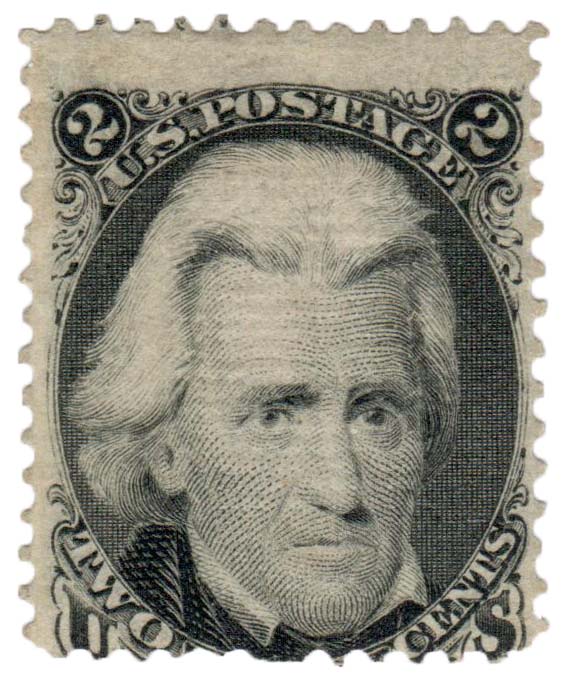
These broken fibers allowed cancellation ink to thoroughly penetrate the paper. This meant even regular pen ink, which was used to cancel stamps at smaller post offices, would be impossible to remove completely.
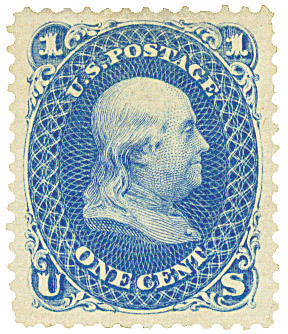
After a test run, Steel’s machine applied the first grills to U.S. #79, which was first known to be used on August 13, 1867. However, because the grill covered the entire sheet, it proved troublesome, weakening perforations and leading some sheets to fall apart. As a result, Steel modified the grilling process, resulting in 10 more major grill classifications. These grills are classified by the dimensions of the grill pattern and are measured in millimeters or by counting the number of grill points.
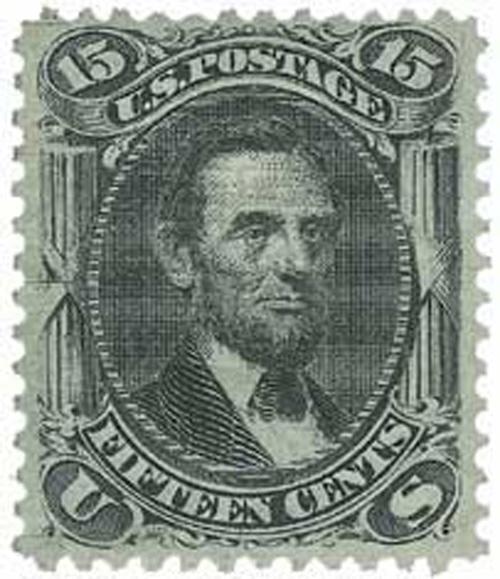
The letters that classify the various grill types do not denote the size, shape, or appearance of the grills. Rather, they simply indicate the order in which they were discovered.
The exception to the rule is the “Z” grill, which was identified by William L. Stevenson. Stevenson could not decide to which family of grills this particular type belonged. Nor did he know which other families it preceded or followed and so he designated it as “Z Grill,” where “Z” signifies the unknown.
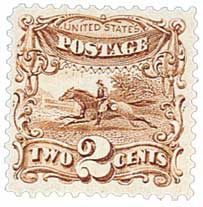
Visible in general from the back of the stamp only, grills may also be felt by lightly running a fingertip over the surface. Depending on which type of roller was used, the pattern may be “points up” or a “points down.” The ridges on an indented roller force the paper into the recesses, creating raised points, while a roller with raised pyramids will cause the points to be forced down into the paper, forming a series of depressions.
The United States was the first country to issue grilled stamps and was the only country to do so until the mid-1870s, when Peru also began using grills. The National Bank Note Company was responsible for producing both countries’ stamps.
Click here to learn more about grills.
U.S. #79
Series of 1867 3¢ Washington
“A” Grill
Earliest Known Use: August 13, 1867
Method: Flat plate
Watermark: None
Perforation: 12
Color: Rose
The A grill was National Bank Note Company first experiment with grilling. It covered the entire stamp area. Since it greatly weakened the paper and perforations, the A grill was discontinued after use on the 3-, 5-, and 30-cent issues.
Grills were made by embossing the stamp, breaking paper fibers, and allowing canceling ink to soak deeply into the paper. This made it difficult to remove cancels and reuse stamps. Charles Steel, who oversaw postage stamp production in the 1860s, patented the grilling method. It was used nine short years – 1867 to 1875. Grilling resulted in some of the greatest US stamp rarities, including the legendary “Z” Grill, US #85A.
Series of 1867
Grills are classified by the dimensions of the grill pattern and are measured in millimeters or by counting the number of grill points. There are eleven major classifications.
“A” Grill Covers the entire stamp
“B” Grill 18x15mm (22x18pts)
“C” Grill 13x16mm (16-17x18-21pts)
“D” Grill 12x14mm (15-17-18pts)
“Z” Grill 11x14mm (13-14x18pts)
“E” Grill 11x13mm (14x15-17pts)
“F” Grill 9x13mm (11-12x15-17pts)
“G” Grill 9-½ x9mm (12x11-11 ½ pts)
“H” Grill 10x12mm (11-13x14-16pts)
“I” Grill 8-½ x10mm (10x11x10-13pts)
“J” Grill 7x9 ½ mm (10x12pts)
The letters that classify the various grill types do not denote the size, shape, or appearance of the grills. Rather, they simply indicate the order in which they were discovered.
The exception to the rule is the “Z” grill, which was identified by William L. Stevenson. Stevenson could not decide to which family of grills this particular type belonged. Nor did he know which other families it preceded or followed and so he designated it as “Z Grill,” where “Z” signifies the unknown.
Visible in general from the back of the stamp only, grills may also be felt by lightly running a fingertip over the surface. Depending on which type of roller was used, the pattern may be “points up” or a “points down.” The ridges on an indented roller force the paper into the recesses, creating raised points, while a roller with raised pyramids will cause the points to be forced down into the paper, forming a series of depressions.
The United States was the first country to issue grilled stamps and was the only country to do so until the mid-1870s, when Peru also began using grills. The National Bank Note Company was responsible for producing both countries’ stamps.
First U.S. Grilled Stamp
Many early U.S. stamps didn’t have set issue dates, so for those, we go by the first known use, which for #79 was 150 years ago today!
In the 1860s, U.S. postal officials grew concerned that people were reusing stamps by washing the cancels off to use the same stamp twice. So Charles Steel, superintendent of stamp manufacture at the National Bank Note Company developed the grill process, for which he was granted a patent on October 22, 1867.

According to Steel’s patent, “The object of my invention is to produce a stamp which shall stick better than usual, and which it shall be impossible to fraudulently remove and use again.” Steel’s machine used a roller pitted with either small depressions or small raised pyramids to break fibers in stamp paper. The rollers with depressions created a “points up” pattern while those with raised pyramids made a “points down” pattern.

These broken fibers allowed cancellation ink to thoroughly penetrate the paper. This meant even regular pen ink, which was used to cancel stamps at smaller post offices, would be impossible to remove completely.

After a test run, Steel’s machine applied the first grills to U.S. #79, which was first known to be used on August 13, 1867. However, because the grill covered the entire sheet, it proved troublesome, weakening perforations and leading some sheets to fall apart. As a result, Steel modified the grilling process, resulting in 10 more major grill classifications. These grills are classified by the dimensions of the grill pattern and are measured in millimeters or by counting the number of grill points.

The letters that classify the various grill types do not denote the size, shape, or appearance of the grills. Rather, they simply indicate the order in which they were discovered.
The exception to the rule is the “Z” grill, which was identified by William L. Stevenson. Stevenson could not decide to which family of grills this particular type belonged. Nor did he know which other families it preceded or followed and so he designated it as “Z Grill,” where “Z” signifies the unknown.

Visible in general from the back of the stamp only, grills may also be felt by lightly running a fingertip over the surface. Depending on which type of roller was used, the pattern may be “points up” or a “points down.” The ridges on an indented roller force the paper into the recesses, creating raised points, while a roller with raised pyramids will cause the points to be forced down into the paper, forming a series of depressions.
The United States was the first country to issue grilled stamps and was the only country to do so until the mid-1870s, when Peru also began using grills. The National Bank Note Company was responsible for producing both countries’ stamps.
Click here to learn more about grills.



